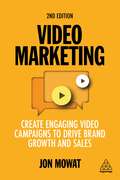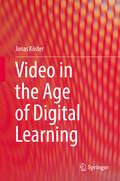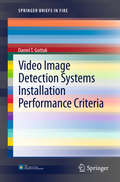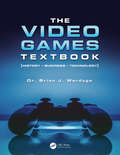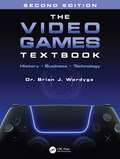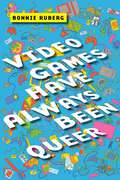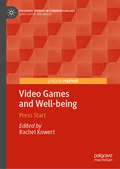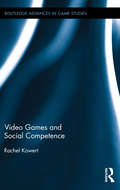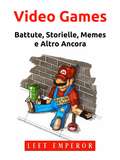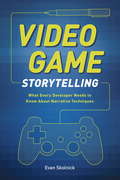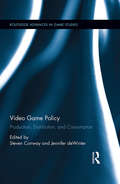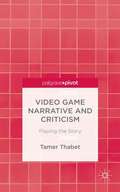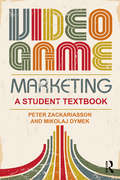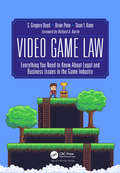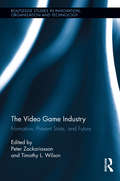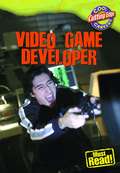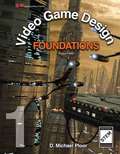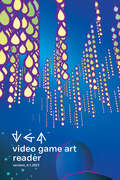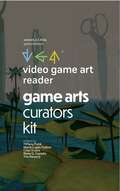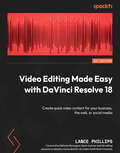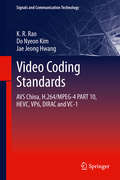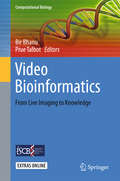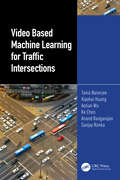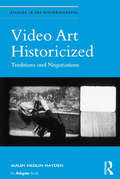- Table View
- List View
Video Marketing: Create Engaging Video Campaigns to Drive Brand Growth and Sales
by Jon MowatIn a 'video first' world, video is one of the most effective tools marketers can use to raise brand awareness, engage consumers, drive website traffic and increase sales. Video Marketing takes a step-by-step and in-depth look at planning and creating great video campaigns, as well as activating, testing and measuring their success. Featuring case studies from global household names such as adidas, Kleenex, and Red Bull, it explores which video types and platforms brands should use, using multi-video campaigns, live videos and webinars, as well as creating and editing video campaigns on a budget using DSLRs and smartphones. Updated with the latest developments, this second edition of Video Marketing contains new chapters on understanding your audience and buying media space on ad networks and social media, as well as further content on personal and personalized content and avoiding potential pitfalls such as frauds, fake views and updates. Accompanying online resources consist of video links for campaigns discussed in the book and a downloadable strategy planner for readers to complete and put into action.
Video in the Age of Digital Learning
by Jonas KösterAlthough video is now ubiquitous in education, its full potential is oftentimes not fully understood, nor is it used to utmost potential. This timely volume seeks to address this gap by providing educators and instructional designers with a comprehensive and in-depth understanding of video production processes and methods for designing effective instructional videos. From its discussion of the significance of digital learning and impact of instructional video to its unique focus on the best design and production techniques that make video an effective teaching tool, this book offers applicable and tested strategies for creating quality instructional video. The accompanying website, which allows readers to see sample videos and access additional online resources, underscores the book’s practitioner focus. Among the topics covered: · Instructional videos for teaching and learning · Design and interactivity of instructional videos · Production, distribution, and integration of instructional videos · The future of instructional video Video in the Age of Digital Learning is an important, practical contribution to the scholarship exploring methods for sharing and acquiring knowledge in the digital age. It promises to be a valuable resource for educators, instructional designers, instructional media producers, and educational technology professionals.
Video Image Detection Systems Installation Performance Criteria
by Daniel T. GottukVideo Image Detection Systems Installation Performance Criteria outlines fire performance objectives and related criteria for VID systems. The book also indentifies conceptual characteristic fire, smoke and nuisance scenarios within a series of selected environments, and examines related performance and installation issues as well. Video Image Detection Systems Installation Performance Criteria is designed for practitioners as a reference guide for implementing video systems capable of quickly detecting smoke and fire. Researchers working in a related field will also find the book valuable.
The Video Games Textbook: History, Business, Technology
by Brian J. WardygaThe Video Games Textbook takes the history of video games to another level, with visually-stimulating, comprehensive, and chronological chapters that are relevant and easy to read for a variety of students. Every chapter is a journey into a different era or area of gaming, where readers emerge with a strong sense of how video games evolved, why they succeeded or failed, and the impact they had on the industry and human culture. Written to capture the attention and interest of both domestic and international college students, each chapter contains a list of objectives and key terms, illustrative timelines, arcade summaries, images and technical specifications of all major consoles.
The Video Games Textbook: History • Business • Technology
by Brian J. WardygaThe Video Games Textbook takes the history of video games to the next level. Coverage includes every major video game console, handheld system, and game-changing personal computer, as well as a look at the business, technology, and people behind the games. Chapters feature objectives and key terms, illustrative timelines, color images, and graphs in addition to the technical specifications and key titles for each platform. Every chapter is a journey into a different segment of gaming, where readers emerge with a clear picture of how video games evolved, why the platforms succeeded or failed, and the impact they had on the industry and culture. Written to capture the attention and interest of students from around the world, this newly revised Second Edition also serves as a go-to handbook for any video game enthusiast. This edition features new content in every chapter, including color timelines, sections on color theory and lighting, the NEC PC-98 series, MSX series, Amstrad CPC, Sinclair ZX Spectrum, Milton Bradley Microvision, Nintendo Game & Watch, gender issues, PEGI and CERO rating systems, and new Pro Files and quiz questions, plus expanded coverage on PC and mobile gaming, virtual reality, Valve Steam Deck, Nintendo Switch, Xbox Series X|S, and PlayStation 5. Key Features Explores the history, business, and technology of video games, including social, political, and economic motivations Facilitates learning with clear objectives, key terms, illustrative timelines, color images, tables, and graphs Highlights the technical specifications and key titles of all major game consoles, handhelds, personal computers, and mobile platforms Reinforces material with market summaries and reviews of breakthroughs and trends, as well as end-of-chapter activities and quizzes
Video Games in Psychotherapy
by Robert RiceVideo Games in Psychotherapy provides the reader with a practical session-by-session framework for using video games, interactive media, and gaming metaphors to help make the process of psychotherapy more engaging for today’s youth. Using concepts from narrative, collaborative, cognitive behavioral, and other evidenced-based approaches to psychotherapy, the book gives examples of possible therapist questions, responses, and activities involving language and concepts that are appealing to young gamers. Addressing issues with psychophysiological self-regulation, anxiety disorders, and autism spectrum disorders, among others, this book uses multiple case examples to demonstrate each idea and is written in a way that is understandable for all mental health providers, regardless of their own familiarity with gaming. A review of over 40 popular video games with specific ideas for their use in psychotherapy is provided, allowing mental health providers to easily individualize therapy based on client goals and gaming preferences. Concepts for individual and group psychotherapy using games and interactive media, ranging from Pac Man to virtual reality, are also covered. Providing the reader with useful templates, worksheets, and other therapy resources, this book is a must-have for mental health providers working with children, adolescents, and transition-age youth.
Video Games Have Always Been Queer (Postmillennial Pop #16)
by Bonnie RubergArgues for the queer potential of video games While popular discussions about queerness in video games often focus on big-name, mainstream games that feature LGBTQ characters, like Mass Effect or Dragon Age, Bonnie Ruberg pushes the concept of queerness in games beyond a matter of representation, exploring how video games can be played, interpreted, and designed queerly, whether or not they include overtly LGBTQ content. Video Games Have Always Been Queer argues that the medium of video games itself can—and should—be read queerly. In the first book dedicated to bridging game studies and queer theory, Ruberg resists the common, reductive narrative that games are only now becoming more diverse. Revealing what reading D. A. Miller can bring to the popular 2007 video game Portal, or what Eve Sedgwick offers Pong, Ruberg models the ways game worlds offer players the opportunity to explore queer experience, affect, and desire. As players attempt to 'pass' in Octodad or explore the pleasure of failure in Burnout: Revenge, Ruberg asserts that, even within a dominant gaming culture that has proved to be openly hostile to those perceived as different, queer people have always belonged in video games—because video games have, in fact, always been queer.
Video Games and Well-being: Press Start (Palgrave Studies in Cyberpsychology)
by Rachel KowertThis book examines how video game mechanics and narratives can teach players skills associated with increased psychological well-being. It integrates research from psychology, education, ludology, media studies, and communication science to demonstrate how game play can teach skills that have long been associated with increased happiness and prolonged life satisfaction, including flexible thinking, openness to experience, self-care, a growth mindset, solution-focused thinking, mindfulness, persistence, self-discovery and resilience. The chapters in this volume are written by leading voices in the field of game studies, including researchers from academia, the video gaming industry, and mental health practitioners paving the way in the field of “geek therapy.” This book will advance our understanding of the potential of video games to increase our psychological well-being by helping to mitigate depression, anxiety, and stress and foster persistence, self-care, and resilience.
Video Games and Social Competence (Routledge Advances in Game Studies)
by Rachel KowertDespite their popularity, online video games have been met with suspicion by the popular media and academic community. In particular, there is a growing concern that online video game play may be associated with deficits in social functioning. Due to a lack of empirical consistency, the debate surrounding the potential impact of online video game play on a user’s sociability remains an active one. This book contributes to this debate by exploring the potential impact of online video game involvement on social competence outcomes, theoretically and empirically. Through empirical research, Kowert examines the relationships between online video game involvement, social goals, and social skills and discusses the underlying mechanisms of these effects.
Video Games: Battute, Storielle, Memes e Altro Ancora
by Leet EmperorAlcune divertenti battute per gli amanti dei video games! Il breve testo propone alcune simpatiche battute sul tema video giochi...per farsi due risate!
Video Game Storytelling: What Every Developer Needs to Know about Narrative Techniques
by Evan SkolnickUNLOCK YOUR GAME'S NARRATIVE POTENTIAL!With increasingly sophisticated video games being consumed by an enthusiastic and expanding audience, the pressure is on game developers like never before to deliver exciting stories and engaging characters. With Video Game Storytelling, game writer and producer Evan Skolnick provides a comprehensive yet easy-to-follow guide to storytelling basics and how they can be applied at every stage of the development process—by all members of the team. This clear, concise reference pairs relevant examples from top games and other media with a breakdown of the key roles in game development, showing how a team&’s shared understanding and application of core storytelling principles can deepen the player experience. Understanding story and why it matters is no longer just for writers or narrative designers. From team leadership to game design and beyond, Skolnick reveals how each member of the development team can do his or her part to help produce gripping, truly memorable narratives that will enhance gameplay and bring today&’s savvy gamers back time and time again.
Video Game Policy: Production, Distribution, and Consumption (Routledge Advances in Game Studies)
by Steven Conway and Jennifer deWinterThis book analyzes the effect of policy on the digital game complex: government, industry, corporations, distributors, players, and the like. Contributors argue that digital games are not created nor consumed outside of the complex power relationships that dictate the full production and distribution cycles, and that we need to consider those relationships in order to effectively "read" and analyze digital games. Through examining a selection of policies, e.g. the Australian government’s refusal (until recently) to allow an R18 rating for digital games, Blizzard’s policy in regards to intellectual property, Electronic Arts’ corporate policy for downloadable content (DLC), they show how policy, that is to say the rules governing the production, distribution and consumption of digital games, has a tangible effect upon our understanding of the digital game medium.
Video Game Narrative and Criticism: Playing the Story
by Tamer ThabetThe book provides a comprehensive application of narrative theory to video games, and presents the player-response paradigm of game criticism. Video Game Narrative and Criticism explains the nature of gameplay - a psychological experience and a meaning-making process in the fictional world of video games.
Video Game Marketing: A student textbook
by Peter Zackariasson Mikolaj DymekThe video game industry has been one of the fastest-growing cultural phenomena of our times with market conditions that demand a specific skill set from its marketers. To a new generation of "indie gamers", being a game developer isn’t just about design and production, a successful video game demands entrepreneurial skills and astute business acumen. The creators need to know what their customers want, how to reach those customers and how to sell to them. Video Game Marketing: A student textbook is for development students or aspiring developers who want to know how to promote and sell the results of their efforts. This book is a much-needed guide to: • the essentials of marketing strategy; • video games as products or services; • marketing research for game development; • branding video games; • marketing through game: gamification, advergames. Replete with pedagogy to aid learning such as objectives and discussion questions for each chapter, this book is all that aspiring video game developers will need to unleash the potential of their games.
Video Game Law: Everything you need to know about Legal and Business Issues in the Game Industry
by S. Gregory Boyd Brian Pyne Sean F. KaneVideo Game Law is aimed at game developers and industry professionals who want to better understand the industry or are in need of expert legal guidance. Given the rise in international competition, the increasing complexity of video game features, and the explosive growth of the industry in general, game developers can quickly find themselves in serious trouble, becoming vulnerable to copyright infringement claims, piracy, and even security breaches. Not every video game company has the financial resources to retain in-house counsel–which Video Game Law seeks to address by discussing many of the common pitfalls, legal questions, and scenarios facing the industry. S. Gregory Boyd, Brian Pyne, and Sean F. Kane, the most prominent, sought after, and respected video game attorneys in the country, break down the laws and legal concepts that every game developer and industry professional needs to know in order to better protect their game and grow their company. KEY FEATURES:• Provides a solid understanding of intellectual property (IP) concepts and laws, includingcopyright, trademark, trade secret, and other protections that apply to video games andhow each can be employed to protect a company’s unique and valuable IP• Explores cutting edge legal issues that affect the gaming industry, including gambling,virtual currency, privacy laws, the Digital Millennium Copyright Act, tax incentives, andrelevant piracy laws• Provides an overview of legal and privacy vocabulary and concepts needed to navigateand succeed in an industry that is constantly growing and evolving• Provides illustrative examples and legal concepts from the video game industry in everychapter
The Video Game Industry: Formation, Present State, and Future (Routledge Studies in Innovation, Organizations and Technology)
by Edited by Peter Zackariasson Timothy L. WilsonThe Video Game Industry provides a platform for the research on the video game industry to draw a coherent and informative picture of this industry. Previously this has been done sparsely through conference papers, research articles, and popular science books. Although the study of this industry is still stigmatized as frivolous and ‘only’ game oriented, those who grew up with video games are changing things, especially research agendas, the acceptance of studies, and their interpretation. This book describes and defines video games as their own special medium. They are not pinball from which they grew, nor movies which they sometimes resemble. They are a unique form of entertainment based on meaningful interactions between individuals and machine across a growing sector of the population. The Video Game Industry provides a reference foundation for individuals seriously interested in the industry at the academic level. As a result, this book will serve as a reference in curricula associated with video game development for years to come.
Video Game Designer (Cool Cutting Edge Careers)
by Chris JozefowiczVideo games are one of today's most popular forms of entertainment. Every day, video game developers draw more and more people into their virtual worlds. If you've got a creative mind and a knack for computers, video game developer might be the job for you. Hear from the pros themselves about what it takes to succeed in this exciting, high-tech career.
Video Game Art Reader: Volume 4
by Tiffany FunkIn computing, overclocking refers to the common practice of increasing the clock rate of a computer to exceed that certified by the manufacturer. The concept is seductive but overclocking may destroy your motherboard or system memory, even irreparably corrupt the hard drive. Volume 4 of the Video Game Art Reader (VGAR) proposes overclocking as a metaphor for how games are produced and experienced today, and the temporal compressions and expansions of the many historical lineages that have shaped game art and culture. Contributors reflect on the many ways in which overclocking can be read as a means of oppression but also a strategy to raise awareness of how inequities have shaped video games. Contributions by Uche Anomnachi, Andrew Bailey, Chaz Evans, Tiffany Funk, D’An Knowles Ball, Alexandre Paquet, Chris Reeves, and Regina Siewald.
Video Game Art Reader: Volume 5: The Game Art Curators Kit
by Tiffany FunkMany ambitious and experimental game forms don't fit into the digital download or retail distribution channels that support so-called “traditional” video games. Instead, these games are supported by a new global movement in video game curation. This special edition of the Video Game Art Reader features an international collaboration of video game professionals working together to create a resource for game exhibition organization, design, and curation. Professionals, artists, and others who organize and curate video game exhibitions and events act within a rhizomatic network of methods, missions, and goals. They establish organizations like galleries, collectives, and non-profits. Methods of sharing video games as critical cultural phenomena continue to evolve and expand. Conceived during the first meeting of GAIA (Game Arts International Assembly), the Game Art Curators Kit documents and shares the collective experience of an international network of video game curators and organizers. Sharing practical tips on everything from accessibility to preservation, the book also serves as a guide to support a new global movement in video game curation.
Video Editing Made Easy with DaVinci Resolve 18: Create quick video content for your business, the web, or social media
by Lance Phillips Stefania MarangoniBoost your audience on social media by leveraging DaVinci Resolve 18 and share impressive micro-content with the guidance of a certified Blackmagic Design training partnerPurchase of the print or Kindle book includes a free PDF eBookKey FeaturesEnhance your content with creative editing, VFX composition, color grading, and sound editing techniquesLearn techniques to generate quick video content to engage and increase your audienceDiscover the latest features and hacks of DaVinci Resolve 18 to realize your creative ideasBook DescriptionMicro content dominates social media marketing, but subpar editing and low-quality videos can shrink your audience. Elevate your social media game with DaVinci Resolve - the world's most trusted name in color grading that has been used to grade Hollywood films, TV shows, and commercials. Version 18 enables you to edit, compose VFX, mix sound, and deliver videos for different platforms, including social media and the web.You'll learn the basics of using DaVinci Resolve 18 to create video content, by first gaining an overview of creating a complete short video for social media distribution directly from within the “Cut” page. You'll discover advanced editing, VFX composition, color grading, and sound editing techniques to enhance your content and fix common video content issues that occur while using consumer cameras or mobile phones.By the end of this book, you'll be well-equipped to use DaVinci Resolve to edit, fix, finish, and publish short-form video content directly to social media sites such as YouTube, Twitter, and Vimeo.What you will learnExplore how to edit, add effects, and post to social media using the new Cut pageDeliver video projects swiftly to a variety of social media formats using the Cut pageFix problems with videos, such as stabilizing footage and syncing audioEnhance the quality of your videos through color correction and other visual effects techniquesDiscover how to use the Neural Engine AI in the Studio Version of DaVinci Resolve to speed up your workAdd subtitles and dubbed audio to help your videos reach a wider audienceWho this book is forThis book is for beginner content makers looking for quick techniques to improve their skills and work. It's also useful for experienced content makers who want to begin using DaVinci Resolve for its advanced features. The book acts as a practical training manual for social media marketers, influencers, short film makers, small business owners creating their own content, vloggers, and film/media studies students at schools, colleges, or universities.
Video coding standards
by K. R. Rao Do Nyeon Kim Jae Jeong HwangThe requirements for multimedia (especially video and audio) communications increase rapidly in the last two decades in broad areas such as television, entertainment, interactive services, telecommunications, conference, medicine, security, business, traffic, defense and banking. Video and audio coding standards play most important roles in multimedia communications. In order to meet these requirements, series of video and audio coding standards have been developed such as MPEG-2, MPEG-4, MPEG-21 for audio and video by ISO/IEC, H. 26x for video and G. 72x for audio by ITU-T, Video Coder 1 (VC-1) for video by the Society of Motion Picture and Television Engineers (SMPTE) and RealVideo (RV) 9 for video by Real Networks. AVS China is the abbreviation for Audio Video Coding Standard of China. This new standard includes four main technical areas, which are systems, video, audio and digital copyright management (DRM), and some supporting documents such as consistency verification. The second part of the standard known as AVS1-P2 (Video - Jizhun) was approved as the national standard of China in 2006, and several final drafts of the standard have been completed, including AVS1-P1 (System - Broadcast), AVS1-P2 (Video - Zengqiang), AVS1-P3 (Audio - Double track), AVS1-P3 (Audio - 5. 1), AVS1-P7 (Mobile Video), AVS-S-P2 (Video) and AVS-S-P3 (Audio). AVS China provides a technical solution for many applications such as digital broadcasting (SDTV and HDTV), high-density storage media, Internet streaming media, and will be used in the domestic IPTV, satellite and possibly the cable TV market. Comparing with other coding standards such as H. 264 AVC, the advantages of AVS video standard include similar performance, lower complexity, lower implementation cost and licensing fees. This standard has attracted great deal of attention from industries related to television, multimedia communications and even chip manufacturing from around the world. Also many well known companies have joined the AVS Group to be Full Members or Observing Members. The 163 members of AVS Group include Texas Instruments (TI) Co. , Agilent Technologies Co. Ltd. , Envivio Inc. , NDS, Philips Research East Asia, Aisino Corporation, LG, Alcatel Shanghai Bell Co. Ltd. , Nokia (China) Investment (NCIC) Co. Ltd. , Sony (China) Ltd. , and Toshiba (China) Co. Ltd. as well as some high level universities in China. Thus there is a pressing need from the instructors, students, and engineers for a book dealing with the topic of AVS China and its performance comparisons with similar standards such as H. 264, VC-1 and RV-9.
Video Bioinformatics
by Bir Bhanu Prue TalbotThe advances of live cell video imaging and high-throughput technologies for functional and chemical genomics provide unprecedented opportunities to understand how biological processes work in subcellular and multicellular systems. The interdisciplinary research field of Video Bioinformatics is defined by Bir Bhanu as the automated processing, analysis, understanding, data mining, visualization, query-based retrieval/storage of biological spatiotemporal events/data and knowledge extracted from dynamic images and microscopic videos. Video bioinformatics attempts to provide a deeper understanding of continuous and dynamic life processes. Genome sequences alone lack spatial and temporal information, and video imaging of specific molecules and their spatiotemporal interactions, using a range of imaging methods, are essential to understand how genomes create cells, how cells constitute organisms, and how errant cells cause disease. The book examines interdisciplinary research issues and challenges with examples that deal with organismal dynamics, intercellular and tissue dynamics, intracellular dynamics, protein movement, cell signaling and software and databases for video bioinformatics. Topics and Features * Covers a set of biological problems, their significance, live-imaging experiments, theory and computational methods, quantifiable experimental results and discussion of results. * Provides automated methods for analyzing mild traumatic brain injury over time, identifying injury dynamics after neonatal hypoxia-ischemia and visualizing cortical tissue changes during seizure activity as examples of organismal dynamics * Describes techniques for quantifying the dynamics of human embryonic stem cells with examples of cell detection/segmentation, spreading and other dynamic behaviors which are important for characterizing stem cell health * Examines and quantifies dynamic processes in plant and fungal systems such as cell trafficking, growth of pollen tubes in model systems such as Neurospora Crassa and Arabidopsis * Discusses the dynamics of intracellular molecules for DNA repair and the regulation of cofilin transport using video analysis * Discusses software, system and database aspects of video bioinformatics by providing examples of 5D cell tracking by FARSIGHT open source toolkit, a survey on available databases and software, biological processes for non-verbal communications and identification and retrieval of moth images This unique text will be of great interest to researchers and graduate students of Electrical Engineering, Computer Science, Bioengineering, Cell Biology, Toxicology, Genetics, Genomics, Bioinformatics, Computer Vision and Pattern Recognition, Medical Image Analysis, and Cell Molecular and Developmental Biology. The large number of example applications will also appeal to application scientists and engineers. Dr. Bir Bhanu is Distinguished Professor of Electrical & C omputer Engineering, Interim Chair of the Department of Bioengineering, Cooperative Professor of Computer Science & Engineering, and Mechanical Engineering and the Director of the Center for Research in Intelligent Systems, at the University of California, Riverside, California, USA. Dr. Prue Talbot is Professor of Cell Biology & Neuroscience and Director of the Stem Cell Center and Core at the University of California Riverside, California, USA.
Video Based Machine Learning for Traffic Intersections
by Tania Banerjee Xiaohui Huang Aotian Wu Ke Chen Anand Rangarajan Sanjay RankaVideo Based Machine Learning for Traffic Intersections describes the development of computer vision and machine learning-based applications for Intelligent Transportation Systems (ITS) and the challenges encountered during their deployment. This book presents several novel approaches, including a two-stream convolutional network architecture for vehicle detection, tracking, and near-miss detection; an unsupervised approach to detect near-misses in fisheye intersection videos using a deep learning model combined with a camera calibration and spline-based mapping method; and algorithms that utilize video analysis and signal timing data to accurately detect and categorize events based on the phase and type of conflict in pedestrian-vehicle and vehicle-vehicle interactions. The book makes use of a real-time trajectory prediction approach, combined with aligned Google Maps information, to estimate vehicle travel time across multiple intersections. Novel visualization software, designed by the authors to serve traffic practitioners, is used to analyze the efficiency and safety of intersections. The software offers two modes: a streaming mode and a historical mode, both of which are useful to traffic engineers who need to quickly analyze trajectories to better understand traffic behavior at an intersection. Overall, this book presents a comprehensive overview of the application of computer vision and machine learning to solve transportation-related problems. Video Based Machine Learning for Traffic Intersections demonstrates how these techniques can be used to improve safety, efficiency, and traffic flow, as well as identify potential conflicts and issues before they occur. The range of novel approaches and techniques presented offers a glimpse of the exciting possibilities that lie ahead for ITS research and development. Key Features: Describes the development and challenges associated with Intelligent Transportation Systems (ITS) Provides novel visualization software designed to serve traffic practitioners in analyzing the efficiency and safety of an intersection Has the potential to proactively identify potential conflict situations and develop an early warning system for real-time vehicle-vehicle and pedestrian-vehicle conflicts
Video Art Historicized: Traditions and Negotiations (Studies in Art Historiography)
by Malin Hedlin HaydenVideo art emerged as an art form that from the 1960s and onwards challenged the concept of art - hence, art historical practices. From the perspective of artists, critics, and scholars engaged with this new medium, art was seen as too limiting a notion. Important issues were to re-think art as a means for critical investigations and a demand for visual reconsiderations. Likewise, art history was argued to be in crisis and in need of adapting its theories and methods in order to produce interpretations and thereby establish historical sense for moving images as fine art. Yet, as this book argues, video art history has evolved into a discourse clinging to traditional concepts, ideologies, and narrative structures - manifested in an increasing body of texts. Video Art Historicized provides a novel, insightful and also challenging re-interpretation of this field by examining the discourse and its own premises. It takes a firm conceptual approach to the material, examining the conceptual, theoretical, and methodological implications that are simultaneously contested by both artists and authors, yet intertwined in both the legitimizing and the historicizing processes of video as art. By engaging art history’s most debated concepts (canon, art, and history) this study provides an in-depth investigation of the mechanisms of the historiography of video art. Scrutinizing various narratives on video art, the book emphasizes the profound and widespread hesitations towards, but also the efforts to negotiate, traditional concepts and practices. By focusing on the politics of this discourse, theoretical issues of gender, nationality, and particular themes in video art, Malin Hedlin Hayden contests the presumptions that inform video art and its history.
